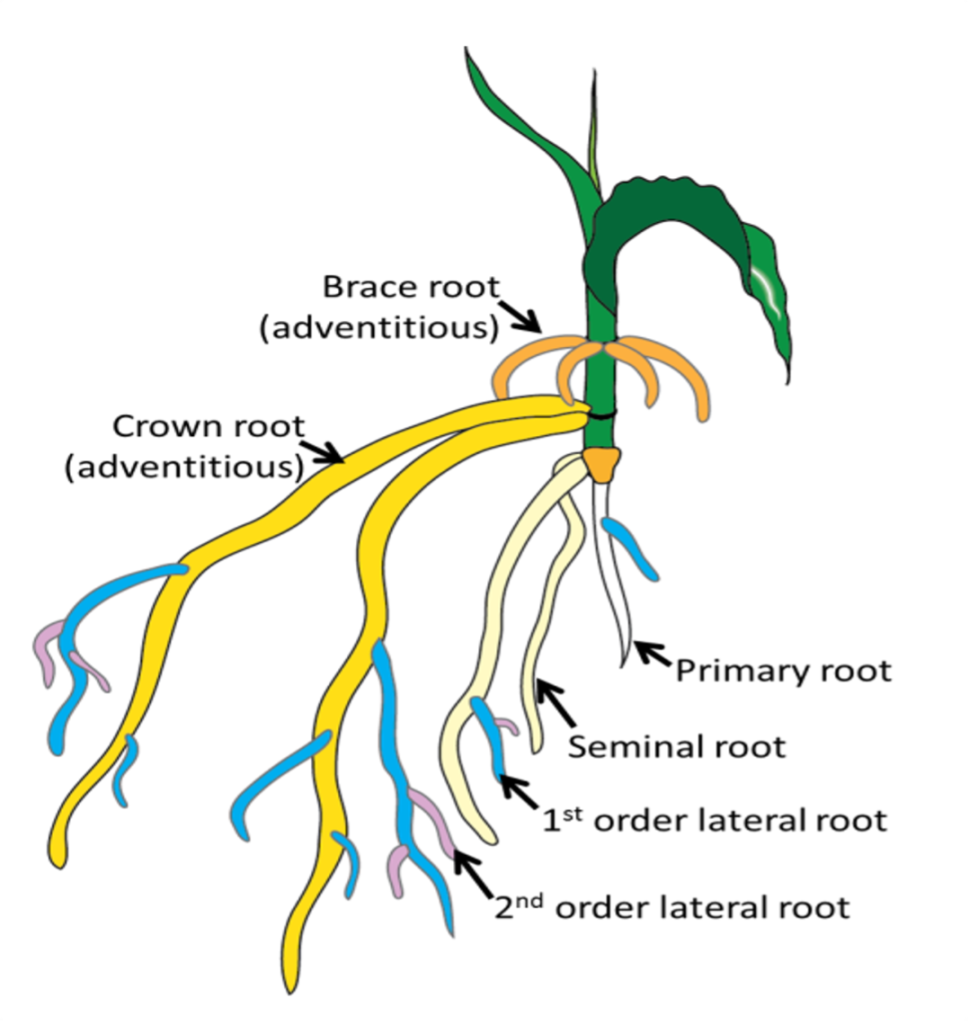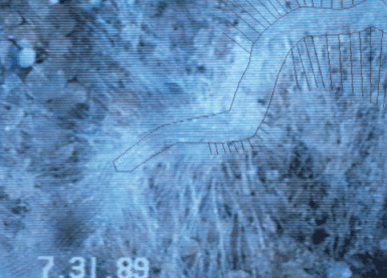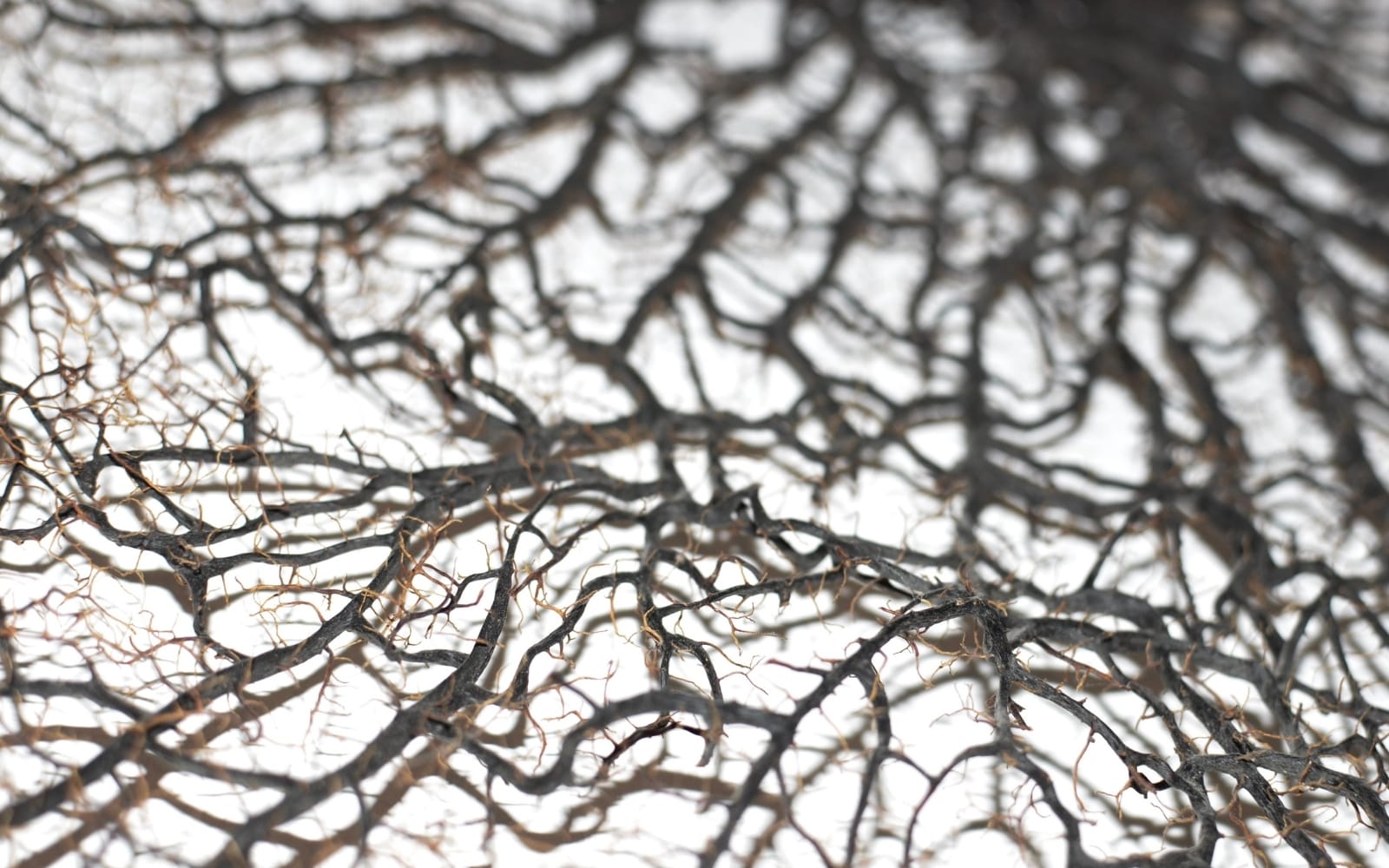August 11, 2025 at 5:56 pm | Updated August 11, 2025 at 10:10 pm | 7 min read
- The root system architecture (RSA) is dynamic and can change due to age, environmental conditions, and nutrient status within a species or plant.
- RSA plays a significant role in the underground basic plant functioning of anchorage and foraging for nutrients and water.
- RSA changes to respond to abiotic stresses in soil, like temperature, drought, salinity, and mechanical resistance.
Since plants are sessile, improving their architecture is beneficial for increasing yield. Besides the aboveground plant form, root architecture can be altered to optimize the use of natural resources. Understanding how the whole root architecture influences plant functioning can be helpful in crop breeding.
Roots System Architecture
Roots are vital for productivity, as they serve multiple purposes, including foraging for water and nutrients, providing anchorage and mechanical support, and offering a surface for symbiotic interactions between plants and microbes.
In the past, the root system was classified by diameter or age, but not functionality. However, with more information being gathered in the last decade, the different roles and dynamics of root systems are emerging.
Subscribe to the CID Bio-Science Weekly article series.
By submitting this form, you are consenting to receive marketing emails from: . You can revoke your consent to receive emails at any time by using the SafeUnsubscribe® link, found at the bottom of every email. Emails are serviced by Constant Contact
The root system architecture (RSA) describes the spatial form and distribution of the root system in the soil, encompassing root morphology, topology, geometry, and distribution. RSA includes two concepts, root shape and structure, which influence how the root system interacts with its environment.
- Root shape defines the location of roots and the arrangement of the root system in the soil. It is quantified by traits such as root depth, root length density, and lateral root expansion.
- Root structure refers to the components of the roots and their interrelationships. The essential traits are topology, which covers branching status, and root geometry, which includes the relative positions of roots and is described by branch lengths and angles, as well as interbranch distance.
Root system architecture (RSA) is a result of developmental processes and is influenced by genetics. The RSA is also a response to external environmental factors, including soil moisture, temperature, pH, nutrient availability, and microbial communities. The RSA is dynamic also due to temporal variations resulting from the growth of different root axes and their associated physiological functions, the diversity of root types within a plant, and soil heterogeneity.
Importance of RSA
Root system architecture is vital for plant and agricultural productivity, as nutrient and water distribution in the soil is uneven. So, the spatial distribution of roots determines a plant’s ability to access soil resources.
Scientists aim to comprehend the RSA and its functions to enhance crop adaptability to a changing climate and increase yield. Modifications to RSA by altering root length and number, structure, and root hairs in new cultivars can be crucial for optimized growth, development, and productivity.
The root system architecture functions are altered by the age of the plants or the type of life form (tree or annual). The global functioning of the RSA is an aggregate of the physiological functions, which are coordinated at the root system level. However, functions can vary among different roots and ages. The main areas in which the main RSA is involved are nutrient and water foraging and plant response to stress.

Figure 1: “Root types. White = primary root, cream = seminal roots, blue = first order lateral roots, pink = second order lateral roots, yellow = crown roots, orange = brace roots. Crown and brace roots are both types of adventitious roots. (Original drawing courtesy A Rasmussen),” RSECO.org. (Image credits: https://www.rseco.org/content/definitions.html).
Nutrient Acquisition
Plants must forage patchy soil resources by dynamically altering their RSA, physiology, or both.
Though RSA is controlled by genetics, RSA shows physiological and morphological plasticity to access nutrients. Physiological responses occur before morphological changes, particularly when root elongation or lateral growth is involved. For example, when soil patches were enriched with phosphate (P), perennial species increased P uptake by 80% within a few days.
Plants will also allocate more resources to grow their root biomass in low-nitrogen conditions, adjusting their RSA as needed.
Some aspects of the root system architecture relevant to nutrient foraging are discussed below.
Branch order
The topology, position of the roots, and age of roots can be crucial in nutrient and water acquisition.
The roots that are actively involved in nutrient acquisition arise from the periphery of the root system in response to changes in soil nutrient availability. These are first-order to third-order lateral roots in temperate trees and many crops, such as tomatoes (see Figure 1). The distal ends are thin and are referred to as fine roots. The distal ends of the first to third order roots also host root hairs and are the site of mycorrhizal activity in the case of trees (see Figure 2). The higher-order roots are associated with the transfer of resources to the above-ground parts. Specific root length, root respiration, and tissue nitrogen content are higher at the distal end of the root system in the lower-order roots, indicating more involvement in nutrient acquisition.
It is the first and second-order roots that are also involved in water absorption, while the fourth and fifth-order roots draw water to the rhizosphere and maintain high humidity around the roots.
Plants can sense the availability of resources and grow roots towards the source. Each species has a defined morphology and anatomy, as well as specific means of sensing soil resources and ways in which they alter the RSA to access finite nutrients and water.
Root length can also serve as a predictor of nutrient capture, particularly when competing with other plants for resources. The growth and senescence of roots alter the root structure, providing a competitive advantage to plants and enabling them to increase root length and density, thereby accessing patchy resources. For example, smaller fine roots have a shorter lifespan, and larger fine roots live longer. Thus, the varying functions that different branch orders have, coupled with the fact that lateral roots of different orders need varying amounts of resources to build and maintain, can make the RSA dynamic.
Root respiration differed along the branch order, with finer and thinner roots respiring more than coarser roots.

Figure 2: “Prunus pennslvanica L. (pin cherry) lateral root tip and associated roots hairs growing (‘foraging’) in a patch of nitrogen-enriched sandy soil at the University of Michigan Biological Station in 1989. Individual grains of sand and scores of root hairs are visible in the image. The outline shows the position of the root and root hairs 12 h previously. Lateral root architecture, root hairs, and mycorrhizal hyphae are all responsive to changes in soil resource availability, but relationships between root form and function remain relatively poorly understood,” (Pregitzer, 2008). (Image credits: https://nph.onlinelibrary.wiley.com/doi/10.1111/j.1469-8137.2008.02648.x)
Different Strategies
The RSA of cereal crops exhibits different responses to nitrogen and phosphorus deficiencies. Immobile phosphate accumulates in the topsoil, so cereals grow more shallow seminal roots for phosphate acquisition, especially in the seedling stages. To forage for phosphorus and potassium, cereals also use more axial roots, lateral branching, shallow branching angles, and root hairs.
Nitrates tend to leach into deeper soils, and plants invest in primary and lateral root elongation, shifting resources from vegetative growth. For example, maize grows fewer but deeper roots to access nitrogen more efficiently. Using this strategy, plants can increase rooting depth by 45%. This trait can also be used to access more water during drought.
The origin of roots also matters. Both dicots and monocots grow primary seminal roots. Since cereals lack secondary thickening of their roots, they develop more shoot-borne nodal roots that produce a massive mass, known as a fibrous root system, which also helps prevent plant lodging.
Specialized root morphologies, such as mycorrhizae and nitrogen-fixing symbiotic nodules, also help improve nutrient acquisition. Cluster roots that are shallow form dense mats in the upper soil in many plant families (Betulaceae, Casuarinaceae, Eleagnaceae, Fabaceae, Myricaceae, Mimosaceae, and Moreaceae), to help forage for phosphorus and iron.
Stress Response
The root system must overcome various abiotic stresses in the soil, including temperature, drought, and mechanical resistance.
Temperature fluctuations
Both dicot and monocot RSA are sensitive to soil temperatures. Deviations from the optimum temperatures can decrease primary root length, angle, and densities of lateral roots. For example, the ability of maize seedlings to grow at high densities of long lateral roots is preferable for maintaining vigor. Being able to grow long roots in high temperatures supports more photosynthesis and dry matter accumulation.
As temperature increases, there is more evapotranspiration, leading to more soil drought and salinity, which can co-occur. Salinity can inhibit the growth of both primary and lateral roots. Plants respond by exhibiting negative halo tropism, bending away from salty soils to avoid salinity.
Water stress
However, soil drought causes taproots to grow deeper roots with a less acute angle, and more of first- and second-order roots. Drought produces thinner but deeper roots during less rainfall.
In regions with an average annual rainfall of < 1,000 mm, in grasslands, scrublands, and deserts, the maximum rooting depths were correlated with rainfall, except for shrubs and trees. Rooting depth was shallow in arid regions and deeper in humid soils. However, as the canopy size increases, the root biomass is deeper in arid conditions than in moist soils. Other factors, like soil texture and plant species, also influence root depth.
Excess water is also a stress, as it causes hypoxia (low oxygen). In such cases, plants form aerenchyma by enlarging the air spaces between cells or through cell death. A trade-off in root morphology allows plants to continue water and nutrient uptake.
Mechanical resistance
Roots can encounter mechanical resistance during growth and require force to move soil particles to elongate. Dicots with larger roots are more successful than monocots with roots of smaller diameter. Roots change diameter and length due to the mechanical resistance they face through ethylene production.
Phenotyping Roots
Recent technological advances have made in situ phenotyping of root traits possible. Using the information will require integration with genetic studies. For this, root image acquisition and analysis are considered the optimum means of data collection on RSA.
CID BioScience Inc. offers In-Situ Root Imagers for non-destructive and repeated scanning of underground roots in minirhizotron systems. The camera captures high-resolution 360° images of roots growing around installed transparent root-tubes. The free analytic software RootSnap! detects and estimates root length, diameter, area, volume, branching angle, and mortality with precision, aiding research in RSA.
Find out more about the CI-600 In-Situ Root Imager and the CI-602 Narrow Gauge Root Imager and their application for your root research.
Sources
Cochavi, A., Cohen, I. H., & Rachmilevitch, S. (2020). The role of different root orders in nutrient uptake. Environmental and Experimental Botany, 179, 104212. https://doi.org/10.1016/j.envexpbot.2020.104212
Hodge, A., Berta, G., Doussan, C. et al. Plant root growth, architecture, and function. Plant Soil 321, 153–187 (2009). https://doi.org/10.1007/s11104-009-9929-9
Khan, M. A., Gemenet, D. C., & Villordon, A. (2016). Root System Architecture and Abiotic Stress Tolerance: Current Knowledge in Root and Tuber Crops. Frontiers in Plant Science, 7, 209303. https://doi.org/10.3389/fpls.2016.01584
Maqbool, S., Hassan, M. A., Xia, X., York, L. M., Rasheed, A., & He, Z. (2022). Root system architecture in cereals: Progress, challenges and perspective. The Plant Journal, 110(1), 23-42. https://doi.org/10.1111/tpj.15669
Pregitzer, K. S. (2002). Fine roots of trees – a new perspective. New Phytologist, 154(2), 267-270. https://doi.org/10.1046/j.1469-8137.2002.00413_1.x
Pregitzer, K. S. (2008). Tree root architecture – form and function. New Phytologist, 180(3), 562-564. https://doi.org/10.1111/j.1469-8137.2008.02648.x
RSECO.org. (n.d.). Plants in Action- Definitions. Retrieved from https://www.rseco.org/content/definitions.html
Related Products
Most Popular Articles
- Transpiration in Plants: Its Importance and Applications
- Leaf Area – How & Why Measuring Leaf Area…
- How to Analyze Photosynthesis in Plants: Methods and Tools
- Plant Respiration: Its Importance and Applications
- The Forest Canopy: Structure, Roles & Measurement
- Stomatal Conductance: Functions, Measurement, and…
- Forest & Plant Canopy Analysis – Tools…
- Root Respiration: Importance and Applications
- The Importance of Leaf Area Index (LAI) in…
- Irrigating with Saline or Seawater






